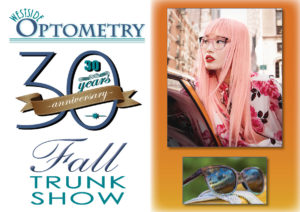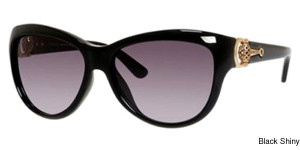- Even if your distance glasses prescription isn’t very strong, put them on at the start of any long trip. You’ll tire less quickly and feel better at the end of the drive if you are not straining to see.
- Keep your windshield clean inside and out. Filming on either side of the windshield can cause a veiling glare when bright light hits it, and every bit of road spatter on the windshield becomes two bits of annoying spatter (one for each eye) when you are looking at a far distance.
- Your rear view mirrors should be adjusted properly, and that should be done after you have the seat positioned, and never use the vinyl cleaning and brightening agents on your dashboard because they make the veiling glare effect of reflected light from the dashboard worse.

- Be sure you are not tilting your head into a chin-up position as you drive. This can cause you to have eyestrain and even distance blur from your prescription lenses. Adjusting the seat upward and tilting the steering wheel downward may help you keep a good head position.
- Wait until the sun is fully up before putting on sun lenses for driving, and take your sun lenses off before dusk sets in. Dusk and dawn drive times are known to be times at which you need all the light you can get for safe driving.
- Your eyes will tend to get tired if you simply stare straight ahead on long road trips, so keep your eyes moving as you check your mirrors and potential hazards from either side.
- Make a point of “triple blinking” (i.e., three fast, full blinks in quick succession) every few minutes especially if your eyes feel dry and have a burning sensation.
- Don’t stare at bright incoming headlights. A prolonged look at bright lights will mean a prolonged glare recovery period after you look away from them.
- Blinking lights such as another driver’s turn signal or the lights of an emergency vehicle can hold your visual attention long after those lights are no longer relevant to your safety.
- Take frequent stretch breaks and stop before you start feeling tired on long road trips. While on break, turn your eyes up, down, right, left and toward all directions in between as far as you can. This can refresh the muscles that aim your eyes, and it will tend to ward off eye fatigue.
Category: Sunglasses
Fall Eyewear Event and 30 years
Westside Optometry is combining the fall trunk show with the beginning of Dr. Griffith’s 30th year in optometry. Stop by the office to have a snack and try on the latest eyewear from Kate Spade and Maui Jim.
The office is open regular hours, 9:00 – 6:00, but the festivities are between 2:00 and 6:00 on Tuesday, September 11th.
Looking forward to seeing you.
Quality Sunglasses
Sunglasses not only offer style but they offer protection from damaging ultraviolet radiation. Quality sunglasses are more expensive and worth it because of the premium optics, coatings, frames and style.
 The optics of your sunglasses determine the clarity and comfort of vision. Polarized lenses like Maui Jim minimize glare and reflections.
The optics of your sunglasses determine the clarity and comfort of vision. Polarized lenses like Maui Jim minimize glare and reflections.
Sunglass lens treatments increase visibility and comfort. Backside anti-reflective coatings reduce glare from behind and repel water and dust. A mirror coating further reflects annoying light and glare.
Well-made frames start with quality materials that resist breakage and bending. The weight and balance of the frame is important for comfort as well.
Frames are styled for specific sports or can be highly fashionable. The details may include flexible hinges, variable color combinations and wrap styling. 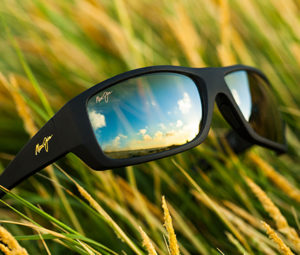
Don’t skimp on your sunglasses. You deserve the best comfort, protection and style.
Bright Winter Eyes
Protecting our eyes in the winter is essential for preventing short and long term problems.
Eye dryness is very common, especially on cold brisk days. Finding comfort near a warm toasty heater or fireplace can dry the eye surface too. Maintain good eyelid hygiene, stay hydrated and use artificial tears to control mild dry eye symptoms.
 Sunglasses are important for preventing keratitis (a burn on the cornea surface) and aging effects such as cataracts, pinguecula and macular degeneration. Snow-blindness or keratitis is a painful corneal condition that can occur when the outermost layers of the cornea are damaged (like a sunburn). Damage can occur in as little as an hour of exposure to ultraviolet radiation, the risk is intensified at higher altitude.
Sunglasses are important for preventing keratitis (a burn on the cornea surface) and aging effects such as cataracts, pinguecula and macular degeneration. Snow-blindness or keratitis is a painful corneal condition that can occur when the outermost layers of the cornea are damaged (like a sunburn). Damage can occur in as little as an hour of exposure to ultraviolet radiation, the risk is intensified at higher altitude.
Damage to the eye doesn’t stop on the surface. Cumulative ultraviolet exposure damages the lens of the eye causing cataract formation. Research has also found that UV radiation contributes to macular degeneration.
Wearing good UV blocking sunglasses protects all layers of the eye. The UV radiation reflected off of water and snow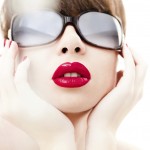 is dangerous too.
is dangerous too.
Don’t hang-up your sunglasses because it is winter, year-round UV protection is a proactive way to promote good eye health and clear vision for adults and children.
Sun Protection
Most of us take precautions to protect our skin from the damaging sun radiation by putting on a hat and applying sunscreen.
A significantly smaller percentage of people put on sunglasses to protect the eyes from the same ultraviolet risks. Besides glare and discomfort from the brightness, the ultraviolet (UV) rays from the sun cause premature aging to the skin around the eye and the structures of the eye. In fact, the sun is the greatest environmental factor contributing to cataract formation.
SUNGLASSES provide a barrier to other eye irritants as well. Wearing sunglasses protects the eyes from wind, dust, pollen and debris. This is particularly beneficial for sports like cycling and running. 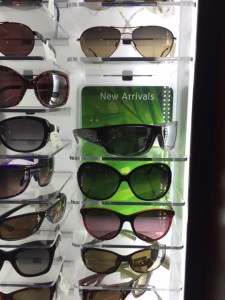
COMFORT from good quality sunglasses is attributed to reducing glare and eliminating squinting. Glare can be direct from the light source or indirected (reflected). Reflected glare is eliminated best with polarized lenses. Polarized lenses are especially helpful for watersports, fishing and on the snow, skiing and snowboarding.
QUALITY SUNGLASSES will protect against all UV wavelengths (A,B and high energy wavelengths). The lenses will be centered and have clearer optics than the sunglasses you find at the grocery store and gas stations. A premium sunglass frame is comfortable, fits well and is durable. It is also resistant to corrosion, tarnish, peeling and chipping.
Long-Term UV damage cannot be repaired. It is cumulative. Protect your eyes today, wear quality sunglasses.
And don’t forget the kids, they are more susceptible to UV damage than adults.
5 Tips to Healthy Eyes this Summer
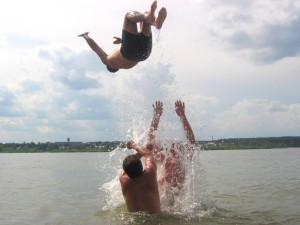 [heading centered=”yes” margin_bottom=”no”]Wear sunglasses with UV protection[/heading]
[heading centered=”yes” margin_bottom=”no”]Wear sunglasses with UV protection[/heading]
Did you know that it is actually possible for your eyes to get sunburned?! Just like your skin, your eyes need protection from the sun. Wearing sunglasses outdoors is very important in protecting your eyes from harmful UV rays. Excessive exposure to UV light can also increase your risk for developing early cataracts and macular degeneration. When looking for a new pair of sunglasses, make sure that they have a minimum UV 400 protection and that they block both UVA and UVB rays. Additionally, sunglasses will provide a shield of protection from dust and debris that can get blown into your eyes, which is a great added bonus, especially on those windy beach days!
[heading centered=”yes” margin_bottom=”no”]Maintain safe wear and care of contact lenses[/heading]
Keep your eyes healthy this summer by practicing safe contact lens wear. Long days, hot weather, travel, and lots of time outdoors can put you at a higher risk of developing a contact lens-related eye problem. In order to minimize this risk don’t forget to maintain proper contact lens hygiene! Remember to make sure that your hands are washed before handling your contact lenses, always use fresh contact lens solution, and minimize contact with water; this includes removing your contacts before going swimming or in a hot tub. And if you notice any redness, irritation, light sensitivity, decreased vision, or discharge, do not wear your contacts and call the office immediately.
[heading centered=”yes” margin_bottom=”no”]Wear protective eyewear[/heading]
Summertime often means working on projects around the house. This can include gardening, painting, remodeling, etc. that can potentially result in small objects flying around. Make sure you wear proper eye protection during these activities. And by eye protection, this does not mean regular glasses or sunglasses, this means professional quality goggles with impact resistant lenses and full coverage frame. You’ll also want to be sure to protect your peepers while playing sports, especially those that utilize small sized balls, such as golf balls, squash balls, and badminton shuttlecocks. Wearing proper eyewear can prevent up to 90 percent of serious eye injuries. If you do experience an eye injury, make sure to call us so that a proper eye health examination can be performed.
[heading centered=”yes” margin_bottom=”no”]Avoid chemicals and natural irritants[/heading]
Chemicals found in pools and bacteria often found in lakes and rivers can be harmful or bothersome to your eyes. Be sure to always wear goggles if you will be opening your eyes while playing or swimming in water. Other natural irritants that you may be exposed to while outdoors or hiking can include poison ivy, oak, and insect bites. If you find yourself outside near these irritants, be mindful of keeping your hands clean after touching plants, as rubbing allergens into your eyes can be very uncomfortable. If you notice any eye irritation, swelling, or redness, after any of these activities, contact the office so we can aid in determining the cause and help relieve your symptoms.
[heading centered=”yes” margin_bottom=”no”]Schedule your yearly eye examination[/heading]
Since you and the kids often have a little extra free time over the summer, it is the perfect time to schedule your annual eye examination?! A comprehensive eye exam is one of the most important preventative ways to preserve vision, and is the only way to accurately assess the health of your eyes, diagnose an eye disorder or disease, and determine if you require corrective lenses. Catching potential eye problems early could save your vision in the future, and that makes for an extremely bright and happy summer! Schedule online.
Bumps on the White of the Eye
There are two types of benign growths that can appear on the white of the eye (conjunctiva).
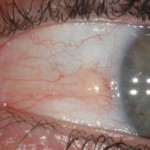 The first type is called a Pinguecula. A pinguecula is a benign growth caused by the degeneration of the conjunctiva’s collagen fibers. Thicker yellow tissue and in some cases calcified deposits, eventually replace the original fibers. It often appears as a thickened, discolored spot between the colored part of the eye and the nose. It is more common in individuals who spend a lot of time outdoors with continued exposure to the ultraviolet light or those who live in sunny, windy equatorial climates. The affected eye might become red and irritated. No treatment is necessary unless discomfort is severe. Prevention is highly recommended and that means sunglasses when outdoors. Artificial tears can help with irritation.
The first type is called a Pinguecula. A pinguecula is a benign growth caused by the degeneration of the conjunctiva’s collagen fibers. Thicker yellow tissue and in some cases calcified deposits, eventually replace the original fibers. It often appears as a thickened, discolored spot between the colored part of the eye and the nose. It is more common in individuals who spend a lot of time outdoors with continued exposure to the ultraviolet light or those who live in sunny, windy equatorial climates. The affected eye might become red and irritated. No treatment is necessary unless discomfort is severe. Prevention is highly recommended and that means sunglasses when outdoors. Artificial tears can help with irritation.
The second type of benign bump on the eye can actually be more problematic. A Pterygium is an elevated, triangular, non-cancerous 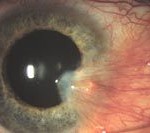 growth that is also usually on the nasal side of the eyeball. A pterygium contains blood vessels and can be of greater cosmetic concern than the pinguecula. The difference between a pterygium and a pinguecula is the tissue they invade. The pinguecula is limited to the conjunctiva and the pterygium grows onto the cornea (clear part of the eye). A small pterygium is treated with artificial tears for comfort and sunglasses for prevention. Sometimes surgery is needed if the vision is affected.
growth that is also usually on the nasal side of the eyeball. A pterygium contains blood vessels and can be of greater cosmetic concern than the pinguecula. The difference between a pterygium and a pinguecula is the tissue they invade. The pinguecula is limited to the conjunctiva and the pterygium grows onto the cornea (clear part of the eye). A small pterygium is treated with artificial tears for comfort and sunglasses for prevention. Sometimes surgery is needed if the vision is affected.
Genetics can play a role in the possibility of having either of these bumps. Wearing protection from UV is your best chance of preventing or controlling pinguecula and pterygia.
Sunglasses
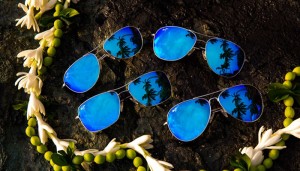
Prolonged exposure to ultraviolet (UV) light may cause cataracts, age-related macular degeneration (AMD), skin cancer, sunburns, and premature aging of the skin. Wearing good quality sunglasses can protect the eyes from harmful effect of UV light.
When it comes to choosing sunglasses, the options are endless and confusing. Not all lenses are equal in terms of UV and blue light protection. Here are a few tips on selecting good optical quality of the lens and the correct level of protection.
UV light
The light spectrum is categorized by wavelength. If the light is in the visible spectrum, the wavelengths will determine its color. If it is in the ultraviolet range, these wavelengths determine its UV category (A, B or C)
Blue Light
A relatively new term, blue light can damage the retina, leading to AMD and blurring of vision.
Sun Lens features:
The color, or tint, of the sunglass lens does not affect its UV and blue light protection. In fact, you can get UV 400 protection in some clear lens materials. To learn more about the different color of sun lenses, click here.
- A mirror on the front of your lenses will reflect most of the direct glare, essentially “squinting” so you don’t have to.
- A polarized filter in your sunglasses will eliminate reflected glare from the road, water and other flat shiny surfaces. With polarized lenses, you can see below the water’s surface, so they are great for fishing.
- A back surface anti-reflective coating will prevent light from bouncing off the back of the lens and into your eyes. This feature reduces glare.
- A photochromic lens will adjust to lighting conditions, getting darker as the lights gets brighter. A photochromic lens is activated by UV rays, so the lens will not change as much inside a car.
- Excellent quality sunglasses will be impact-resistant, light-weight and treated with an anti-scratch coating. They will have high-quality optics, provide sharp, clear and comfortable vision.
- Specialized tints are available for different sports and activities. You can get lenses that maximize your vision for tennis, golf, hunting and fishing.
Sun Frame Features:
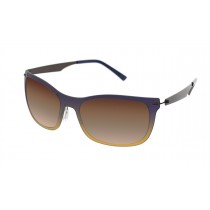 When choosing a sunglass frame, the most important thing to consider is its fit. The frame should fit close to your eyes and face to reduce the entry of bounce back glare. The frame has to be big enough to provide appropriate coverage and protection for your eyes.
When choosing a sunglass frame, the most important thing to consider is its fit. The frame should fit close to your eyes and face to reduce the entry of bounce back glare. The frame has to be big enough to provide appropriate coverage and protection for your eyes.
Most quality sunglasses will be available with your own prescription so you can enjoy clear vision outdoors.
Clip-on sunglasses are available for most prescription glasses. Although these are an acceptable compromise, they add to the weight of you glasses. Also, there will be internal reflection between the two sets of lenses that decreases the quality of your vision.
Select a frame style appropriate for your lifestyle. Fashion sunglasses are beautiful and fully functional at the beach and for running errands. A different style, something lightweight more durable better suited for sports and athletic activities.
Westside Optometry carries the following sunglasses: Maui Jim, Nike, Gucci, Kate Spade, Saks Fifth Avenue and Aspire.
Eyes on the Road
Shorter days and rainy weather, both contribute to difficulty driving. A driver’s vision guides 90% of driving decisions, so good eyesight is essential for road safety.
Start with an eye examination to assess clarity, peripheral vision and eye disease. Having the proper vision skills and prescription are important for many reasons:
Distance vision is imperative for judging distances and reaction time when driving. Poor distance vision increases the risk of making unreliable judgments with potentially disastrous results – even the simplest reactions take 0.4 seconds, so if distance vision is poor, signs or objects may not be seen until it is too late to react safely.
Good Peripheral Vision allows drivers to survey the area without looking away from the road. This includes early recognition of cross-traffic, pedestrians, animals, signs and changes in traffic flow. Impaired peripheral vision can result in the driver failing to react to a hazard on the far left or right, failing to stop at a stoplight suspended over an intersection, weaving while negotiating a curve, or driving too close to parked cars.
Safe Night Driving requires the ability to see in low light conditions and with poor contrast. Impaired night vision can result in tailgating, failing to steer when necessary (since it is difficult to see low contrast features such as edges or irregularities in the road surface), and recover from glare of oncoming headlights.
Glare refers to the disruption of vision due to veiling luminance. Important visual skills for drivers are glare resistance – the extent to which the driver can still see critical objects while facing a steady source of glare (setting sun, headlights), and glare recovery – the rapidity with which the driver’s functioning vision returns to what it was before the glare was encountered. If these skills are not adequate, the driver can miss curves, strike an animal or pedestrian or crash into slow moving or stopped vehicles.
Besides regular eye exams, additional tips for good vision while driving include:
- Always wear sunglasses when driving to reduce glare
- Keep headlights, tail lights , windshields and eye glasses clean
- Keep side and rear view mirrors adjusted correctly to increase your field of vision and reduce glare from headlights
- Always wear glasses or contact lenses if they have been prescribed for driving
Fall Trunk Show
Next month is the annual Westside Optometry Fall Event. This year we are featuring all the Clearvision eyewear collections: Ocean Pacific (OP), Cole Haan, Izod, Ellen Tracy, BCBG and 2 new lines Aspire and Dilli Dalli. Aspire is a lightweight frame design and Dilli Dalli is an incredibly durable design for small children. 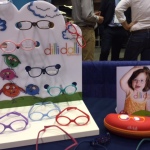
In front of the office, Maui Jim is pitching a tent to display it’s collection of men and women’s sunglasses.
[heading centered=”yes” margin_bottom=”no”]
Date of the show is Saturday September 12, 2015 between 10:00 and 2:00.
Refreshments will be served.
Call ahead if you need an eye examination, or come by to look at glasses.
Bring a friend.
[/heading]
